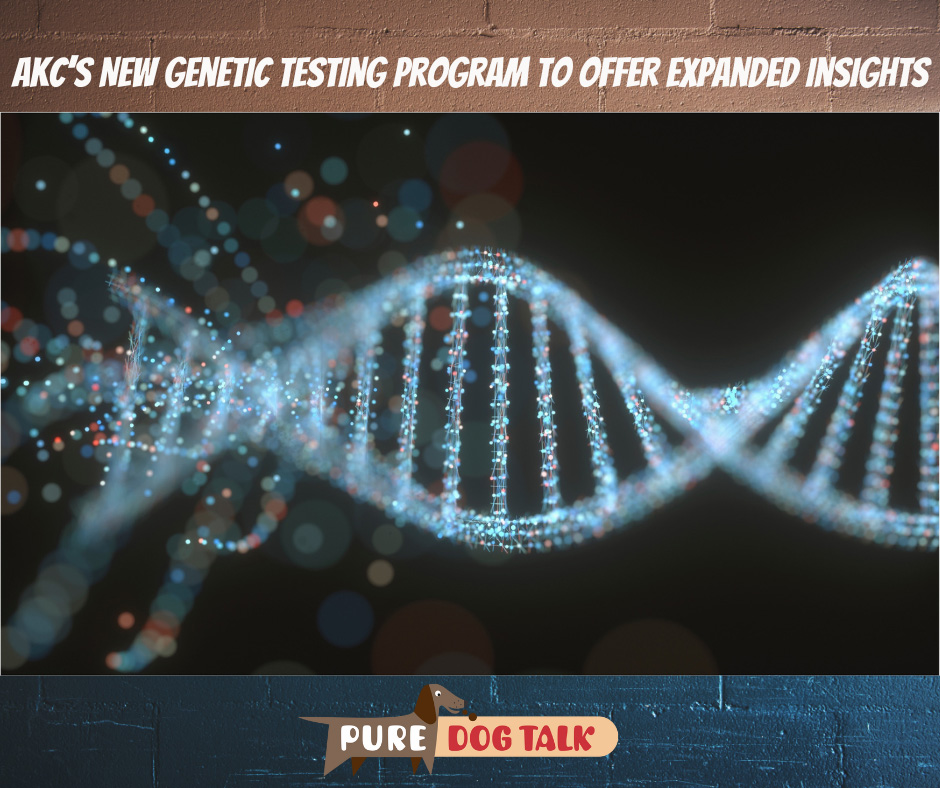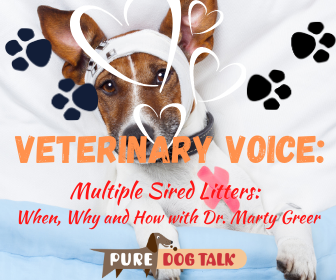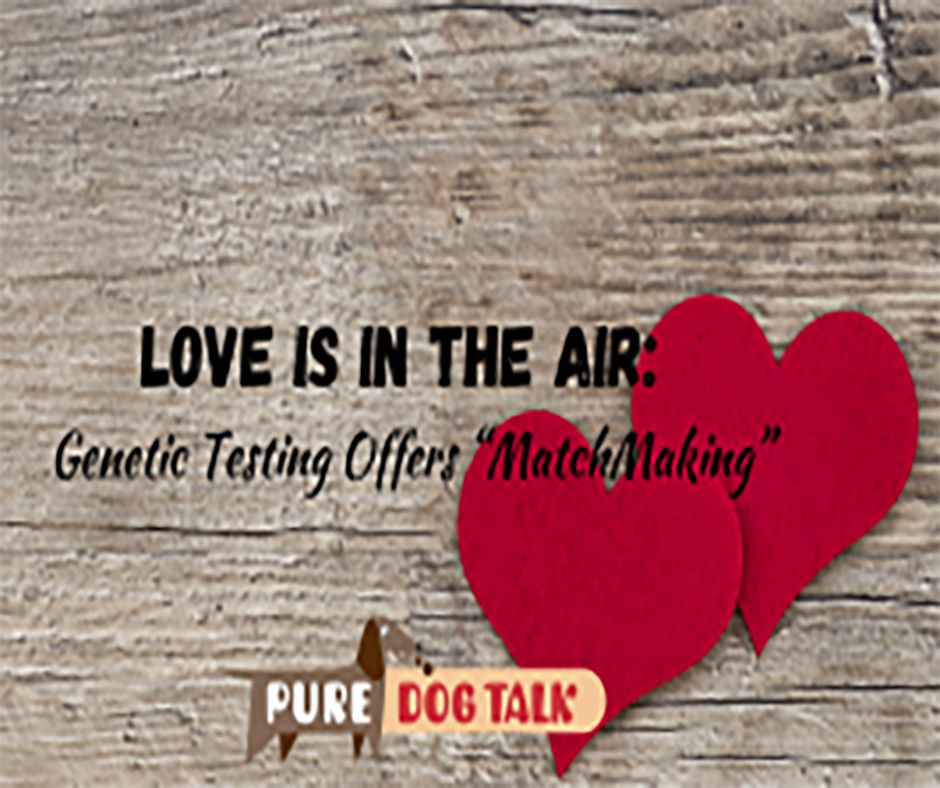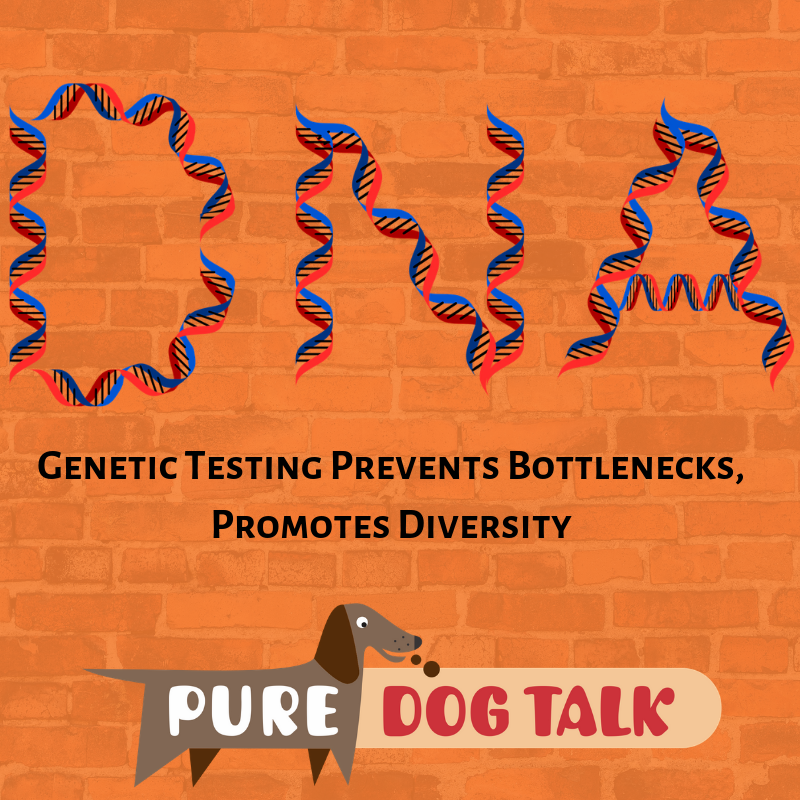568 – AKC’s New Genetic Testing Program to Offer Expanded Insights
AKC’s New Genetic Testing Program to Offer Expanded Insights
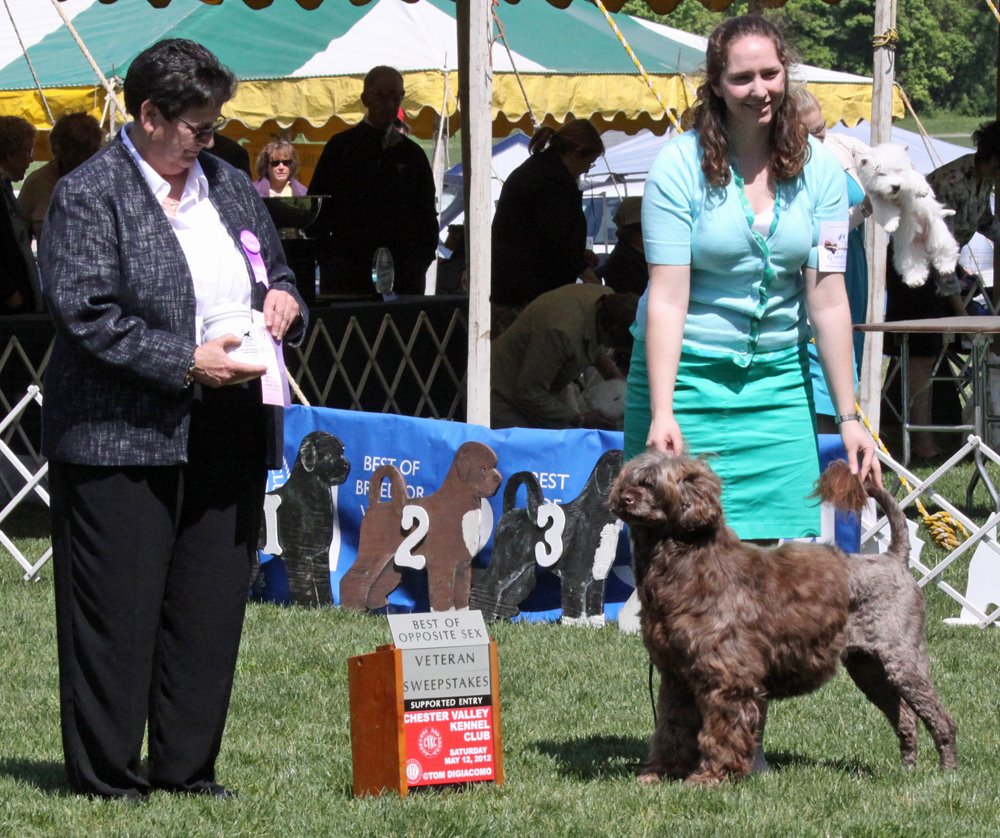
Dr. Claire Wiley, VMD and her Portugese Water Dog.
Dr. Claire Wiley, Executive Director of the AKC DNA Program, joins host Laura Reeves with breaking news about the expansion of their testing capabilities.
AKC’s DNA program will soon include the option to identify traits and genetic diseases, in addition to simple parentage, Wiley announced.
“For the past 25 years, the AKC DNA program has really focused on protecting the registry,” Wiley noted. “And they did that using unique identification, kind of like fingerprints and also using those fingerprints to verify parentage. It had more of a regulatory role to it.
“A couple years ago, the AKC developed an ad hoc genetics committee. They listened to the breeders (who) were really interested in having more from the DNA program. And that’s kind of why I got hired, because we’ve listened to the feedback and are trying to bring things into the future to really serve our most important constituents, the breeder.”
Wiley, a second-generation Portugese Water Dog breeder, is a board certified veterinary specialist in Small Animal Internal Medicine. Her passion for genetic health testing started early in life after losing two PWD puppies to juvenile dilated cardiomyopathy. She later worked on the breakthrough studies to identify the genetic marker for protein losing nephropathy in Soft Coated Wheaten Terriers.
“I’m a breeder. I lived through it from the very beginning and now I’m back here to help bring the DNA program into the future,” Wiley said. “At AKC, we try to focus on all dog owners, but it all starts with the breeders who are producing the healthy dogs for all dog owners.
“The fundamental process will essentially be the same where you use a cheek swab to collect DNA and you go online to activate it. When you first go in to buy the swabs, there will be two products. The original parentage product will be called the AKC Original DNA profile and then the one that includes health tests and traits will be called the AKC Signature DNA profile.
“So when you’re actually on what we call our shop page where you’re buying the swabs, you have an option of choosing either just the Original profile, which is the $50 kit that provides parentage, or you can choose the option that still includes that $50 original profile, but also has health and traits available.
“We’re really hoping to launch this by mid 2023 at the latest, hopefully April. A lot of these companies say there are over 200 markers that they’re testing for, but if you actually talk to breeders, they’re probably focused on 2, 3, maybe 0 for that specific breed. So, we are taking the experts, you know, the Breeders, and having them tell us what we should be including as important markers for them.
“The parent clubs have what we call parent club health statement letters where they actually say this is what we are concerned about as a breed and as a group, and so we’re using those letters to determine which testing is the most important for that breed.”
Listen to the full episode for more from Dr. Wiley.
523 – Special Reproductive Considerations for Rare Breeds
Special Reproductive Considerations for Rare Breeds
Dr. Marty Greer, DVM joins host Laura Reeves to discuss some of the special reproductive considerations for rare breeds. Rare dog breeds offer specific challenges for their breeders including health concerns, limited gene pools, DNA testing mazes and infertility issues.
April is Rare Breeds month here at Pure Dog Talk! Watch for upcoming episodes with deep dives into Norrbottenspets, Chinooks and Nederlandse Kooikerhondje.
“Pick one thing a year that you’re going to try to work through in your breed,” Greer said, quoting from Dr. Ian Dunbar. “Pick what your priorities are. You have to pick. I can’t pick for you. You know your breed. You know your genes. At some point we have to really say this is what I’m going to focus on, this is what I’m going to try to breed for or away from, and try to take those incremental steps. You’re not gonna get it all in one generation.”
How do you eat an elephant…
“I think that’s so important in the rare breed community to emphasize the you eat the elephant one bite at a time,” Reeves added. “It’s really important to recognize that and not get discouraged because you’re trying to swallow a whole elephant. Be committed to that long term process. From a rare breed perspective, that’s one of the things I always emphasize, this is not a fly by night operation. It’s a process, something you’re going to dedicate your entire life to.”
“You work with other people and you’re honest with other people,” Greer emphasized. “So we need to stop hiding things. We need to stop backbiting. We need to stop saying bad things about other people and we need to be really honest with each other and with ourselves so that when you look in the mirror you can say ‘I’m breeding the best dog that I possibly can.’
Full disclosure
“Nobody goes out and deliberately breeds a bad dog but there’s so many aspects to how you have to make these decisions. Without full disclosure you really can’t get there. So we have to be honest with each other. No breeder deliberately produced a dog with a genetic problem, but you’ve got to tell people if you have it because if you double up on it you’re going to have surprises in your litter.
“Longevity, I think, is seriously under-appreciated. I love breeding females that can still have puppies when they’re older. I love breeding old males that still produce sperm. Now that doesn’t mean you can’t freeze semen when he’s young, and you should because then you’ll have access to him, but if he lives to be 16 years old and he was fertile till he was 14, you rock man! That means he didn’t die of orthopedic disease, he didn’t die of bad temperament, he didn’t die because he ran away from home and got hit by a car. He didn’t die from 1,000 things that he could have died from.
Longevity for the win
“Don’t forget about those old guys and their genetics. Go back to the old publications of your breed. Go back to the old pedigrees and take a look and where are those dogs and what are they doing and how long did they live and what was their lifestyle like and what did they die from.”
Greer also strongly recommends purchasing Dr. Jerold Bell, DVM’s book for learning more information on genetic diseases in specific breeds.
488 – Veterinary Voice: Congenital and/or Hereditary Definitions
Veterinary Voice: Congenital and/or Hereditary Definitions
Dr. Marty Greer, DVM joins host Laura Reeves for a deep dive on the question of congenital vs hereditary disease definitions.
“So congenital is something you’re born with, not necessarily inherited, but something you’re born with. Genetic is something that you carry the DNA for,” Greer said. “If you’re born with something, it’s congenital. So, if you’re born with the umbilical cord wrapped around the puppies leg and the leg doesn’t fully develop, that’s congenital because they were born with it but it wasn’t genetic, it was an accident that the cord wrapped around the way. Just ’cause you see it at birth doesn’t mean it’s genetic.
Many diseases, Greer noted, “there is a genetic basis” with a “trigger.”
“An epigenetic or an environmental trigger, is there a nutritional component to it, was there some exposure to a chemical that predisposed the patient to it. So that’s where it starts to get muddy. Not everything that’s genetic is easy to figure out the inheritance pattern for. The things that we can DNA test for now are pretty much autosomal recessive genes,” Greer said.
“Are we throwing dogs out of our gene pool because they have something that’s genetic and we don’t have the right test for it, then we may never have a test for it or it’s not genetic or have some genetic and epigenetic and environmental component to it? As much as we think we understand this stuff, it’s not easy,” Greer added.
“The more we know, the less we know. As we start adding this information to our knowledge base, it’s going to become evident to us that what we thought isn’t really true… all information is valuable, but if you don’t apply it correctly, you’re going to end up bottlenecking your gene pool, as you’re going to throw good dogs out.”
475 – Multiple Sired Litters: When, Why and How with Dr. Marty Greer
Multiple Sired Litters: When, Why and How with Dr. Marty Greer
Dr. Marty Greer and host Laura Reeves review the when, why and how of multiple-sired litters. AKC instituted the policy for multiple-sired litters in 2000 with the advent of reliable parentage DNA testing.
Planning for a multiple-sired litter requires taking a variety of factors into consideration.
- The quality and condition of the semen. Greer notes that poor-quality semen should get a “head start” and be inseminated first. Frozen, fresh chilled and live semen all have different rates of motility and viability as they journey toward the eggs.
- The age and reproductive viability of the bitch. Greer advocates for a first litter. “I like a pink, shiny, healthy new uterus,” Greer said. “But it’s got the risk of not knowing what her fertility is and it’s got the risk of not knowing what kind of maternal skills she has.”
- Cost is a factor, as sire, dam and all puppies require DNA parentage testing through AKC in order to be properly registered.
- The “relatedness” of the sires being considered. While DNA testing can differentiate related sires, a father and son or similar closely related dogs can be more challenging to nail down. “We had a Border Terrier… usually they go out, I think, 13 genes and they had to go out 23 because the dogs were so closely related,” Greer said.
- The knowledge and experience of your veterinarian. “(Work) with somebody that does a lot of canine reproduction. This is not for your ordinary, garden variety veterinarian. Those are good people, don’t get me wrong, but when you’re doing something of this level of sophistication, you need to have somebody that doesn’t misunderstand what you want to do and doesn’t think that fresh chilled semen goes in the freezer and knows how to put it in so that it gets into the uterus.”
- Freeze potential sires while they are young and healthy. “If you have a young up and coming stud dog, freeze early and freeze often. Even if it’s not up and coming, even if it just might be up and coming … if he’s good enough for you to keep, freeze him. You can always do the health screenings later.”
- Consider creating a “sperm bank” for your national breed club. Working with AKC, Greer said the prototype created by the Otterhound Club of America is now available to all clubs. “We’ve got a tool kit put together. Our next step is to start educating breed clubs. So if you’re listening and you have a breed club and you’re on the genetics committee or you’re a member or you have a dog that you would like to have semen retained on this is really really, really super important. We’re going to need to breed our way out of some of these corners and without that genetic material stored, it’s not going to happen. So, you now have the opportunity to work with your breed club, your veterinarian, the AKC, the society for theriogenology… there’s a whole bunch of people that are involved in this because everybody sees the big picture value of this.”
426 – Love is in the Air: Genetic Testing Offers “MatchMaking”
Love is in the Air: Genetic Testing Offers “MatchMaking”
Adam Boyko, chief science officer at Embark, joins host Laura Reeves for a science geek out session.
“There’s really three important reasons to do genetic testing,” Boyko said. “The first is the health component that you get from genetic testing. In almost every purebred breed there are inherited disorders we can test for today. It’s good to get that peace of mind. It’s good to know if a dog is a carrier for something if you’re planning on breeding it. It’s good (for owners) to know if it’s at risk or something so you know what to look out for, if there’s a special diet you should be feeding it or what sort of environment you should have that dog in.
“Secondarily, you’ve got genetic traits, which scientists have learned a lot about. So, you might want to know what sort of coat colors the dog carries. If you were to breed it what would you expect the litter proportions to be. It’s also coat type, stature all that kind of stuff.
“Finally, inbreeding. Breeders have really been interested in (this) a lot. They’ve been traditionally using pedigree-based methods to (measure COI), but now that we have genomic information you can actually much, much more accurately measure inbreeding, to predict inbreeding of different crosses and see the affect that inbreeding has on the health and longevity of dogs. (It’s) another breeding decision that breeders use, another metric, as they’re trying to balance all the different things.”
Embark’s new “Matchmaker” tool is now online for select breeds, which allows breeders to select different combinations to determine which one offers the lowest COI, which dog carries or doesn’t for which traits or diseases, and would therefore offer the breeder the ideal mating they are seeking.
Visit Embark’s website for more information on services available for your breeding program.
237 — DNA Genetic Testing Prevents Bottlenecks, Promotes Diversity
DNA testing can provide useful information for all breeders
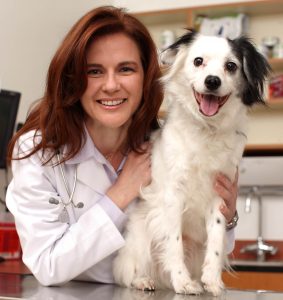
Angela Hughes DVM PhD, Veterinary Genetics Research Manager, Wisdom Health
Testing our dogs’ DNA provides details on everything from ancestry in mixed breeds to disease mutations and genetic diversity in purebred dogs. Dr. Angela Hughes, Veterinary Genetics Research Manager at Wisdom Health, talks about the different types of DNA genetic testing.
“A breed is a specific combination of alleles,” Hughes said. “And 99 percent of the DNA in a Great Dane is the same as a Chihuahua. It’s that one percent that is so important.”
DNA Panel tests, Hughes said, test for genetic mutations. The Wisdom Health Optimal Selection panel tests for 180 different specific diseases that are broken out by which are identified and correlated within each breed.
Focus on genetic diversity.
“Studies show that losing genetic diversity causes loss of reproductive health, increased disease incidence, even decreased hunting ability,” Hughes said.
Purebred dog breeders are succeeding with test and replace breeding theories, Hughes believes. She referenced a study of dogs in the U.S., mixed breed and purebred, in which of all diseases tested for, 34 disorders were found only in mixed breeds, not in purebred dogs.
While Hughes acknowledges that “you can have healthy highly inbred dogs,” she notes that breeders have to be incredibly selective to achieve that.
“The average breeder doesn’t have the time and resources, the number of dogs necessary or enough information to be that highly selective,” Hughes said.
Genetic diversity in dogs will be different even in full siblings, Hughes said. For full littermates, on average, about 50 percent of the DNA is the same. This power of DNA testing, Hughes noted, is that it can help identify which of two dogs, similar in quality and pedigree, is the best match in terms of genetic diversity. Simple pedigree analysis and COI (coefficient of inbreeding) can’t provide that information.
Skip the Bottleneck
The diversity testing also helps avoid bottlenecks in a breed’s gene pool due to popular sire syndrome. She defines this as any sire with more than 100 puppies produced. In an example based on studies of Golden Retrievers in England, in a gene pool of six generations, with 31,259 individual animals represented, the testing revealed only 67 genetically unique individuals.
“DNA testing doesn’t tell you who to breed, it tells you who to breed to,” Hughes reiterated. “This is the last piece. Do all the other testing – conformation, temperament, health, function – then do this.”
Importantly, Hughes also noted that breeders should be careful to not lose the “essence of the breed” in search of genetic diversity.
“You want to move the needle,” Hughes said. “Just shift the curve in the direction of diversity.”
https://www.optimal-selection.com/
164 – Busting the Genetic Testing Myths: Dr. Jerold Bell|Pure Dog Talk
Stick around for input from Allison Foley at the Leading Edge Dog Show Academy about tips for successfully using a flat iron to groom drop-coated dogs.
And take a minute to stop by https://blog.feedspot.com/dog_podcasts/ and check out the top 15 dog podcasts! Of which we are one!

